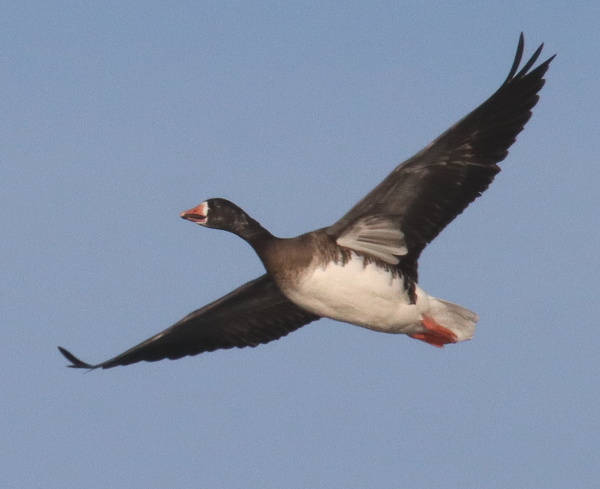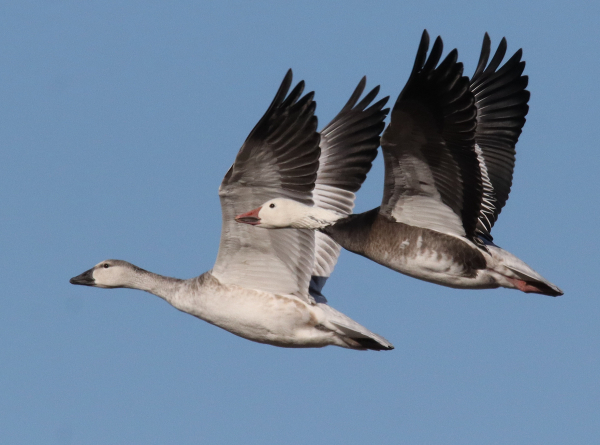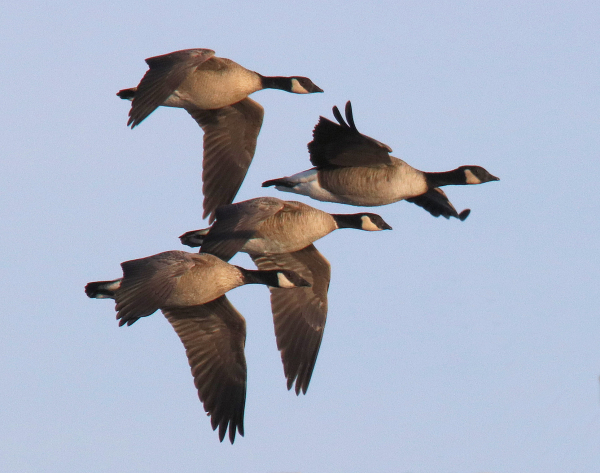
Flocked with White-fronted Geese, an extremely rare hybrid between a White-fronted Goose and a white morph Snow Goose was photographed in flight just a half-mile to the south.

In this image of a first-year white morph Snow Goose flying in tandem with an adult hybrid white morph and blue morph Snow Goose, note the white belly plumage that is similar to the hybrid White-fronted Goose in the first photograph.

Although these Arctic-nesting Cackling Geese resemble Canada Geese, they are much smaller with a comparatively shorter neck and bill and higher-pitched calls.
|
Rare birds come in many packages – a rare species far from its normal range, a new species documented in a state, province, or county; a new bird for your life list or yard list – but while photographing flocks of 3 species of geese a half-mile from my office Friday, I was especially surprised to find a rare bird! A rare bird, in this case an apparent hybrid, which I refer to as the white-bellied White-fronted Goose that appears to be a hybrid between a White-front and a white-morph Snow Goose – ultra-rare, but now documented by my photos.
While awaiting small flocks of geese that were taking flight regularly from Melody’s Marsh to wing past my position to feed in a harvested soybean field, I noticed the hybrid goose as soon as it took flight with about a dozen White-fronted Geese. Its white belly was obvious as soon as it lifted off the ice where a concentration of several hundred geese – a mix of Cackling Geese, White-fronted Geese, and Canada Geese were resting and drinking between feeding sessions. I was immediately excited and followed the unique goose’s flight through my camera lens, taking initial photos of it among the rest of the flock, then zeroing in on the hybrid to get closer images of it in flight.
While reviewing my photos that evening, I could see that in addition to the white belly plumage, the tail was white like a Snow Goose, and most of the bird’s underwing axillary feathers (nearest to the body) were white. This hybrid was at least a year old judging by the white plumage surrounding its bill.
I discounted the possibility that this bird was leucistic – a partial albino – because of the way the plumage looked compared to other partial albino birds I’ve encountered. Instead, the white belly plumage was like the white belly that hybrid blue morph Snow Geese have, which are the result of a mating between blue morph and white morph Snow Geese. While these Snow Goose crosses are quite common among Snow Geese in the Central Flyway, an intra-species hybrid between a Snow Goose and a White-fronted Goose is extremely rare anywhere. What a surprise to find it, and what a thrill to document this rare individual!
A Freezing Update
Although I predicted freeze-up would consume area wetlands last week, I didn’t imagine it would happen in such a short span of time. While most marshes had an initial sheet of ice covering them Thursday morning after overnight lows in the teens, by Friday only the largest lakes had open water. That made Thursday and Friday especially exciting, and I made the most of those sunny days to photograph the giant flocks of Snow Geese with some Ross’s Geese mixed in, while also photographing Cackling Geese, White-fronted Geese, and Canada Geese that were in mixed flocks, noticeably separated from the Snows.
Although I covered a lot of the surrounding area, including recent trips to Bismarck 130 miles to the northwest and to Fargo 140 miles to the northeast, it was clear that within the southeast quarter of the state, I was in the center of the waterfowl action. And some of my most enjoyable time in the field was spent just a half-mile south of my office at Melody’s Marsh where I enjoyed photographing the White-fronts, Cacklers, and Canada Geese, and another mile south a huge flock of Snow and Ross’s Geese were feeding in a succession of fields that provided more photo ops.
Another mega-flock of geese provided a memorable photo session about a dozen miles to the north, and a particularly wary cloud of geese was active just 5 miles north, while another huge flock centered just a mile northeast of home. I was thrilled to be in the midst of it all and share a few photos here, with more provided in this week’s Bird Photography feature, which has some added photography insights.
A few Tundra Swans remained Thursday in groups of 24 (Dean’s Lake), 9 (Swan Marsh), about 160 (Meier’s Lake), 7 (Church Lake), and 28 (Train Lake), while I estimated about 300 at Cindy’s Lake the day before. Even so, it was the last hoorah to find swans in the area before they resumed their migration from the Arctic to the Chesapeake Bay area of Maryland and Virginia where they will spend the winter.
The first Bald Eagle and Rough-legged Hawk in at least 10 days appeared within 2 miles of one another Saturday, and while I haven’t seen a Northern Harrier for about the same period, I don’t expect to see another harrier during winter. That’s also true for Red-tailed Hawks – although I’m still holding out for a Harlan’s Red-tail sighting or two, passing through from their summer range in Alberta, British Columbia – maybe even Alaska. A couple large flocks of 60 or more Lapland Longspurs and a couple flocks of about a dozen Snow Buntings were also Saturday highlights.
Only the deepest big lake, Carlson Lake, had open water by Saturday, which concentrated geese toward that lake and the surrounding harvested corn fields. I expected that concentration would get larger and larger until that lake froze over, but even though the wind kept the big lake from freezing, Sunday it was pretty clear that most geese left the area overnight. Just one giant flock of Snows and Ross’s Geese remained to the north Sunday afternoon, with thousands of geese landing surprisingly near a harvesting combine, semitruck, and other active farm equipment.
By Monday afternoon, Carlson Lake remained 95 percent free of ice, partly due to a strong northwest wind, but the open water seemed to be keeping thousands of geese, mostly Snow Geese, in the area. Also, perched on the edge of the open lake was an immature Bald Eagle, a white-belly, suggesting it was a second- or third-year bird. This was the first of what would normally be a considerable concentration of Bald Eagles there, numbering in the twenties some years and in the thirties 2 years ago. It will be interesting to see how many eagles arrive in the coming days, and how long the geese remain.
New Finches & More
Wednesday several new House Finches frequented my feeders, but one finch stood out among them – a female Purple Finch, which of course is not purple, or even red, but with darker brown markings than the female House finches and a slightly larger size. Although the Purple Finch made repeated visits Wednesday, I didn’t see her again thereafter. A resurgence of House Finch activity was apparent Sunday, including 3 new males, all very brightly colored in red. It seemed like Monday was the coldest of cold outside and a light snow added a melancholy feeling as I filled my feeders, but the sight of a Pine Siskin provided added to a brighter outlook.
At least 2 White-breasted Nuthatches continue to visit my feeders regularly, and a male and female Hairy Woodpecker stop by periodically, but I haven’t seen the female Downy for a couple weeks. When the female Hairy came to the feeder Tuesday, she remained for extended periods between feeding, resting on the side of the feeder out of the wind.
Fall Redux
As a point of reflection, looking back at the fall, I haven’t seen a big falcon, not a Peregrine or a Prairie Falcon; and there have been none of the regular native sparrows in my yard or surrounding areas – no Harris’s Sparrows, or White-crowned or White-throated Sparrows. Even juncos have been few and far between so far. At the same time, it’s been a great fall for shorebird sightings with American Golden Plovers and Black-necked Stilts at the top of the list, and it’s been a great fall for geese and Tundra Swans.
Freeze-up is a significant turning point though, and after the super-abundance of waterfowl evacuates, there is a lull in the action and a transition that must be made even in my own thought waves. The cold landscape will be widely vacant, birds will be few and far between, yet the birds that remain or pass through will be impressive. But there will be other seasonal birding sites to visit, in northern Minnesota and central South Dakota, and like the birds before me, a migration may follow as winter encroaches. Throughout the season I’ll be sharing my weekly birding highlights, and with December at hand, I hope you finish out the year with some memorable birding episodes. Good Luck!
Article and photos by Paul Konrad
Share your bird sightings and photographs at editorstbw2@gmail.com